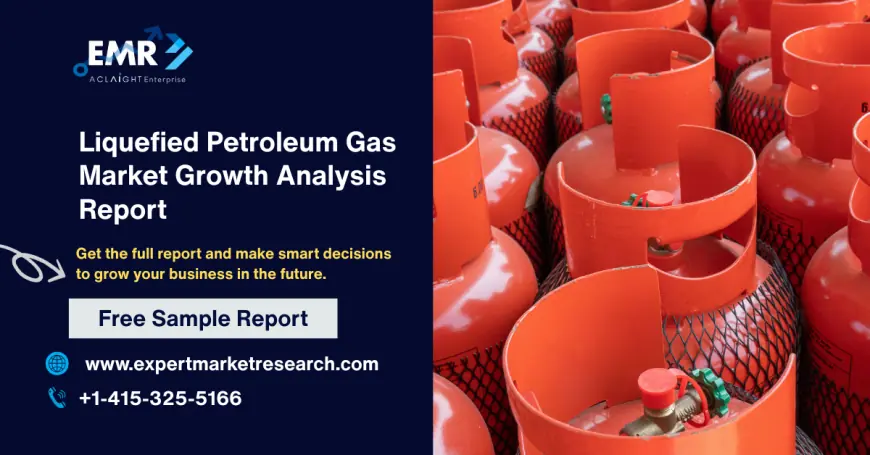Liquefied Petroleum Gas Market Growth Analysis Report - EMR
The global liquefied petroleum gas market to grow from 341.31 MMT in 2024 to 392.22 MMT by 2034, driven by a 1.40% CAGR during the forecast by 2034.

Liquefied Petroleum Gas Market Overview
Liquefied Petroleum Gas (LPG) market remains a vital energy source worldwide, utilized across residential, industrial, transportation, and commercial sectors. As the world shifts toward cleaner fuel sources while industries modernize, LPG is poised for sustained growth. This report outlines market segmentation, regional dynamics, competitive landscape, and long-term trends shaping LPG through 2034.
Market Snapshot
-
Global LPG Market recorded strong volume and value growth in 2024.
-
Forecasted CAGR of ~5–6% from 2025 to 2034, driven by demand in emergent economies and modern applications.
-
Expected to reach a notably higher valuation and consumption levels by 2034.
Market Drivers
-
Transition to Cleaner Fuels
LPG emits fewer emissions compared to coal, diesel, or bunker oil. Its low carbon presence positions it as a preferred bridge fuel, supporting global decarbonization efforts in industry and power generation. -
Residential Demand in Emerging Regions
Population expansion and electrification efforts are increasing LPG usage in homes for cooking and heating—particularly in South Asia, Latin America, and parts of Africa. -
Industrial Manufacturing Needs
Industrial processes like metalworking, glass making, food processing, and ceramics use LPG for its controllable, consistent flame and cleaner burn characteristics. -
Transport Sector Adoption
Autogas (LPG for vehicles) is gaining traction due to favorable pricing, lower emissions, and policy support in parts of Europe and Asia, especially for taxi fleets and delivery vehicles. -
Flexible Sourcing Strategy
Suppliers blend LPG from refinery outputs, associated gas from oilfields, and non-associated gas processing—making supply resilient and responsive to fluctuating crude and natural gas trends.
Segmentation
By Source:
-
Refinery-Sourced LPG: Derived from fractional distillation of petroleum.
-
Associated Gas-Based LPG: Captured from gas produced alongside crude oil.
-
Non-Associated Gas-Based LPG: Extracted from conventional or unconventional gas fields independent of oil.
By Application:
-
Residential: Home cooking and heating.
-
Petrochemical: Feedstock for ethylene and propylene production.
-
Industrial: Manufacturing, boilers, workshops, and process heating.
-
Transport: Autogas, fleet vehicles.
-
Commercial: Hospitality and institutional cooking, heating.
-
Others: Agriculture, horticulture, backup generators.
By Sales Channel:
-
Institutional Sales: Bulk distribution to government, utility, or industrial consumers.
-
Retail Sales: Cylinder or packaged LPG for households, small businesses, and local retailers.
Regional Analysis
Asia Pacific
A major growth region due to rising middle-class households, supportive LPG subsidy programs, and expanding auto conversions to autogas. Demand in India, Pakistan, and Southeast Asia continues to climb.
North America
North America shows gradual LPG growth. It benefits from shale gas extraction (non-associated LPG) and fleet conversions. US regulatory incentives are supporting autogas adoption.
Europe
Policy-driven shift to low‑carbon energy, especially in transport and residential heating. LPG is favored where natural gas grid access is limited, backing fleet transition projects.
Latin America
Growing urbanization and infrastructure investment support LPG usage. Nations like Brazil and Argentina have historic dependence on LPG cylinders, with ongoing growth.
Middle East & Africa
Despite abundant oil, LPG is expanding domestically due to rural electrification needs and limited natural gas pipelines. Government fuel distribution programs are accelerating adoption.
Competitive Landscape
-
Major Producers & Suppliers: Shell, ExxonMobil, TotalEnergies, BP, and Sinopec leverage integration from upstream to delivery networks.
-
Regional & Niche Players: OQ (Oman), Petronas (Malaysia), and local LPG distributors in India and Brazil hold significant market share.
-
E-commerce & Delivery Platforms: New entrants offer LPG cylinder delivery to households via apps, boosting ease-of-access.
-
Infrastructure Investment: Building new cylinder exchange networks, commercial bulk terminals, and fleet fueling stations is reshaping competitive advantage.
Key Market Trends & Developments
-
Cylinder-Size Innovation: Smaller, lighter LPG cylinders are being introduced for easier handling—especially in urban and small home settings.
-
Digital Distribution Platforms: Online ordering, predictive delivery, and IoT-enabled monitoring systems are improving safety, inventory efficiency, and customer convenience.
-
Blending with Renewable LPG: Bio-LPG (synthetic, low-carbon LPG) blends are gaining traction as producer incentives, especially in Europe.
-
Regulatory Support: Clean-energy subsidy programs, autogas incentives, and rural fuel access initiatives are expanding usage in target regions.
-
Climate-Worthy Packaging: Suppliers are transitioning to recyclable or refillable cylinder designs to comply with sustainability goals.
Future Outlook (2025–2034)
-
Clamp-down on Emissions means LPG should grow in residential heating, hospitality, and light industry sectors.
-
Autogas momentum is likely to continue, especially for urban and shuttle applications.
-
Industrial and petrochemical feedstock demand will be strong, supported by population and infrastructure expansion.
-
E-commerce disruption may change supply chains and customer relationships.
-
Green LPG adoption could redefine market segments and support longer-term climate strategies.
Challenges & Risks
-
Price Volatility: LPG value fluctuates with crude oil and natural gas prices.
-
Competition from Alternatives: Natural gas, electricity, renewables threaten demand in some end-use industries.
-
Regulatory Uncertainty: Subsidies or bans may shift demand quickly.
-
Infrastructure Limitations: Rural and remote areas require higher investment to expand supply networks.
Strategic Recommendations
-
Diversify Supply Mix: Use multiple LPG sources to stabilize price and avoid disruptions.
-
Invest in Cylinder Logistics: Make distribution more convenient and traceable with tech-enabled tank tracking.
-
Explore Autogas Rollouts: Engage early with fleet operators, taxis, and public transport providers.
-
Pilot Green LPG: Start with small-scale bio-LPG projects in regions with climate policy support.
-
Expand Digitally: Use apps and IoT to enhance customer experience and inventory forecasting.
FAQs (Search‑Friendly Additions)
Q1: What is LPG and how is it sourced?
LPG is a blend of propane and butane derived from oil refining or natural gas processing. It includes refinery, associated, and non-associated sources—each varying in composition and purity.
Q2: Which sectors primarily use LPG?
Residential (cooking, heating), commercial (restaurants, hotels), industrial (manufacturing, boilers), transport (autogas), and petrochemical feedstock.
Q3: What drives LPG market growth by 2034?
Key factors include clean-fuel policies, autogas adoption, improved delivery networks, residential demand, and low-carbon LPG feedstock incentives.
Q4: Which region is growing fastest for LPG?
Asia Pacific leads, thanks to subsidy programs, urbanization, and autogas adoption in India and Southeast Asia.
Q5: Is LPG environmentally friendly?
LPG produces less carbon and particulate emissions than coal or fuel oil. While still a fossil fuel, it's a cleaner short-to-medium‑term option, and bio-LPG blends elevate its sustainability profile.
Q6: What challenges face the LPG market?
Price swings, stronger alternatives, regulation shifts, and supply network constraints present the main hurdles.
Q7: Can LPG support transportation?
Yes—autogas (LPG for vehicles) reduces fuel costs and emissions. Light-commercial fleets, public transit, and taxi services are increasingly using it.
Conclusion
By blending clean-energy drivers, tech-led distribution, and expansion into transport and industrial use, LPG is well-positioned for steady growth through 2034. Companies that diversify sourcing, invest in infrastructure, and embrace digital tools will shape the future of the LPG market.
Company Name: Claight Corporation
Email: [email protected]
Toll Free Number: +1-415-325-5166 | +44-702-402-5790
Address: 30 North Gould Street, Sheridan, WY 82801, USA
Website: https://www.expertmarketresearch.com
What's Your Reaction?
 Like
0
Like
0
 Dislike
0
Dislike
0
 Love
0
Love
0
 Funny
0
Funny
0
 Angry
0
Angry
0
 Sad
0
Sad
0
 Wow
0
Wow
0

















































